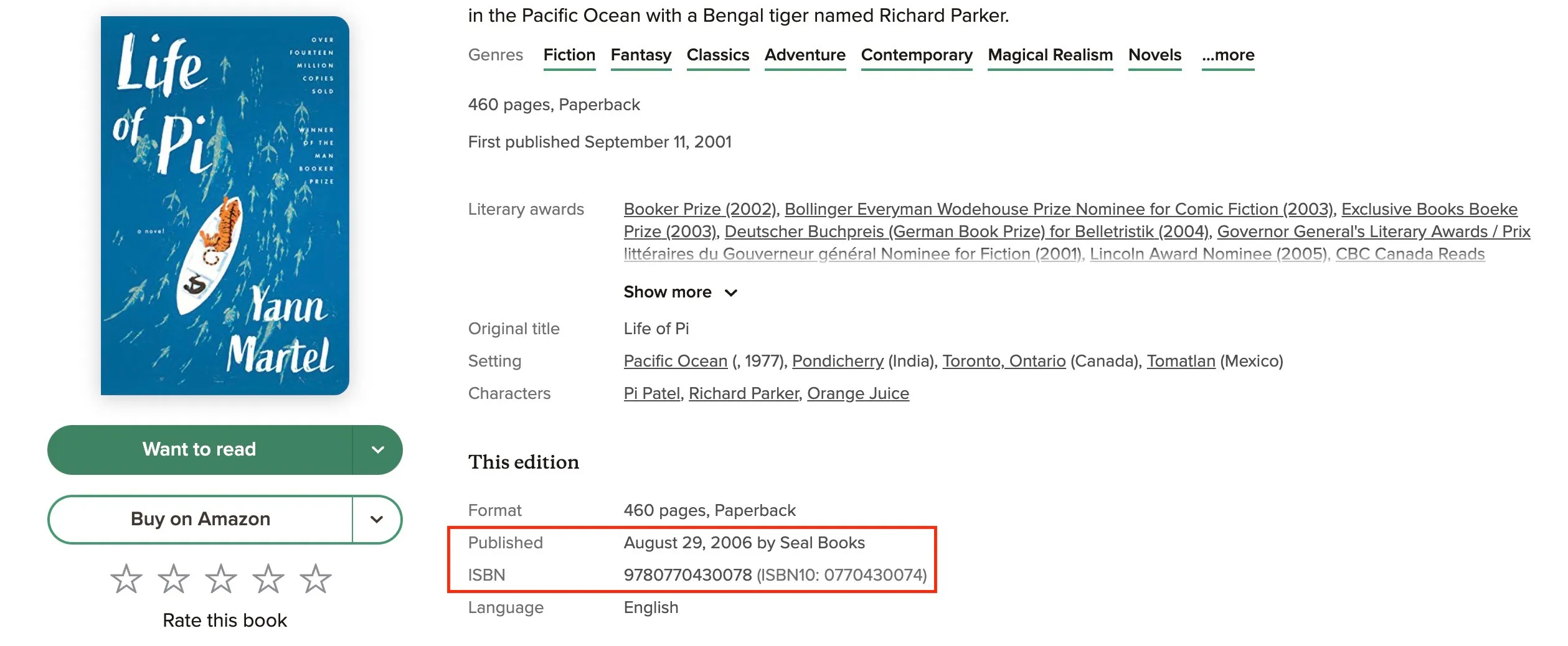
ISBN-10 Explained & Validating 10-Digit ISBN
Discover the hidden meaning behind ISBN numbers! Learn how these 10-digit codes are structured, what each section represents, and how check digits are calculated to ensure accuracy in book identification.
The International Standard Book Number (ISBN) is a unique identifier for books, intended to simplify distribution and purchase. It’s a code that carries within it some key information about the book it’s attached to.
Modern publishing platform and online book marketplaces only use 13 digit ISBN numbers. Even books that were published before 2007 are now listed in 13 digits ISBN format, as converting ISBN-10 to ISBN-13 is easy. By adding 978 before the ISBN-10 and matching the last check digit (see below), you can convert 10 digits to a 13 digit ISBN number. Below is an example of a book published before 2007 and its 2 types of ISBNs.

In this blog post, we’ll dissect the anatomy of a 10-digit ISBN and understand what each part signifies.
What is an ISBN?
Before we delve into the specifics, let’s briefly touch upon what an ISBN is. An ISBN is a 10 or 13-digit number that identifies a book’s edition and publisher. It’s used worldwide and is a crucial part of the book publishing process.
The Structure of a 10-Digit ISBN
A 10-digit ISBN is divided into four parts, each separated by a hyphen. These parts are:
- Group or Country Identifier: This number represents the language or the country of the publisher. For instance, ‘0’ and ‘1’ are used for English-speaking countries, ‘2’ for French-speaking countries, ‘3’ for German-speaking countries, and so on. It can contain up to five digits and is assigned by the International ISBN Agency.
- Publisher Identifier: The publisher identifier represents the publisher of the book that carries the ISBN. It can include up to seven digits. The publisher’s ISBN agency for the respective group (country, geographical region, or language area) assigns these identifiers. Larger publishers have shorter identifiers, while smaller publishers have longer ones.
- Title Identifier: This number is specific to the edition of the book. Each edition of a book (hardcover, paperback, etc.) will have a different title identifier. The title identifier is used to identify the specific edition of a book that has been assigned an ISBN. It can contain up to six digits. If needed, the length of the ISBN is padded to 10 digits by adding leading zeros to the title identifier.
- Check Digit: The check digit is the final digit of the ISBN. It is calculated based on the other nine digits of the ISBN and serves as a verification of the ISBN’s validity. If an error occurs while transcribing the ISBN, such as a numerical error or a transposition mistake, the resulting ISBN will likely be invalid, thus highlighting the error.
Decoding the ISBN
Let’s take an example to understand this better. Consider the ISBN: 0-596-52068-9
- ‘0’ is the Group Identifier, indicating this book is published in an English-speaking country.
- ‘596’ is the Publisher Identifier, indicating the publisher is O’Reilly Media.
- ‘52068’ is the Title Identifier, unique to this specific edition of the book.
- ‘9’ is the Check Digit, validating the ISBN.
How Check Digit is Calculated
The check digit is computed using the nine digits that make up the group identifier, publisher identifier, and title identifier. The first digit is multiplied by ten, and each subsequent digit is multiplied by a number one less than its predecessor, from left to right. The second digit is multiplied by nine, the third by eight, and so on, until the ninth digit, which is multiplied by two. The products of these nine calculations are then summed. The check digit is the remainder of the sum after subtracting multiples of 11. For instance, if the first three identifiers of a book are 0-596-52068-9, the calculation would proceed as follows:
Calculating a Check Digit
ISBN without check digit: 0-596-52068-check digit or 0,5,9,6,5,2,0,6,8
Weight: 10, 9, 8, 7, 6, 5, 4, 3, 2
| ISBN Digit | 0 | 5 | 9 | 6 | 5 | 2 | 0 | 6 | 8 |
|---|---|---|---|---|---|---|---|---|---|
| Weight | 10 | 9 | 8 | 7 | 6 | 5 | 4 | 3 | 2 |
| Multiply (Digit X Weight) | 0 | 45 | 72 | 42 | 30 | 10 | 0 | 18 | 16 |
Sum: 0 + 45 + 72 + 42 + 30 + 10 +0 + 18 + 16 = 233
233 divided by 11 gives a remainder of 2.
The check digit is 11 - 2 = 9
The check digit can range from zero to ten, with the letter “X” representing ten. This is why some 10-digit ISBNs end with an “X”.
How ISBN Check Digit is Validated
A complete ISBN, including its check digit, can be validated using a similar process to the check digit calculation. The same calculation is performed, with the check digit added to the calculated product with a weight of one. If the check digit is “X”, it is considered as 10. If the sum of these products is divisible by 11 (i.e., the remainder is zero), the ISBN is valid. However, this validation only checks the correctness of the check digit and does not necessarily mean that the ISBN has been assigned to a book or is valid in other respects.
Validating a Check Digit
ISBN with check digit: 0,5,9,6,5,2,0,6,8,9
Weight: 10, 9, 8, 7, 6, 5, 4, 3, 2, 1
| ISBN Digit | 0 | 5 | 9 | 6 | 5 | 2 | 0 | 6 | 8 | 9 |
|---|---|---|---|---|---|---|---|---|---|---|
| Weight | 10 | 9 | 8 | 7 | 6 | 5 | 4 | 3 | 2 | 1 |
| Multiply (Digit X Weight) | 0 | 45 | 72 | 42 | 30 | 10 | 0 | 18 | 16 | 9 |
Sum: 0 + 45 + 72 + 42 + 30 + 10 +0 + 18 + 16 + 9 = 242
242 divided by 11 gives a remainder of 0, indicating a valid ISBN.
In Conclusion
The 10-digit ISBN, though it may seem like a random string of numbers, carries within it a wealth of information. It’s a testament to the thoughtfulness and precision that goes into book publishing and distribution. Understanding its structure and purpose can provide valuable insights into the world of books and publishing.
Remember, as of 2007, the book industry internationally has transitioned to a 13-digit ISBN format, but the 10-digit format is still widely recognized and used. Whether you’re an author, a publisher, or a book lover, knowing the anatomy of an ISBN can certainly add to your literary knowledge!

Rajeev Joshi
Blogger and Social Media Manager
Rajeev Joshi is a part-time blogger who writes about book publishing and marketing. In addition to creating online content, he is a health and nutrition expert who assists individuals in losing weight and living an active lifestyle.
More posts by Rajeev Joshi

